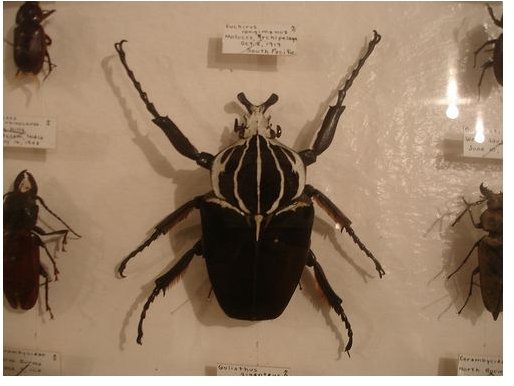The Goliath Beetle: The Strength of an Ox in a Tiny Package
If there was a competition to determine the strongest insect in the world, the hands down winner would be the Goliath Beetle. Some other scarab beetles come close in the strength as a measure of weight movement to size category but none come close in sheer movement of mass. The Goliath beetle strength is a function of its size and environment. It is more than just a big bug; it’s the clean-up crew of the jungle and spends most of its life processing dung and decaying organic matter.
What Does it Look Like
If you ran across a Goliath beetle in the wild (let’s pretend you wouldn’t have to be in a jungle in Africa), how would you know it was a Goliath beetle and not something else? First, it would have the signature reinforced wings (elytra) covering the back two-thirds of its body. If it started to fly around, you might notice its large second set of membranous wings.
The Goliath has sharp claws at the end of each of its six legs. They use these for climbing and this is not to say that they wouldn’t hurt if the beetle tried to climb you, but in general it wouldn’t hurt unless it was losing its balance. Goliath beetles also have prominent black and white (or brown and white) stripe patterns across their entire thorax region.
Telling whether the beetle is male or female is a snap. The male has a Y-shaped horn protruding from the front of its head. It uses this to lift things and to fight with other males for the rights to a mate. Females have a wedge-shaped head that they use for digging burrows in which to deposit their eggs.
Size and Strength
While the Goliath Beetle is not the longest beetle, it is considered the largest due to its magnificent size. Males can reach up to four and a half inches and weigh as much as three and a half ounces. Females are slightly smaller and top out at three inches with weights ranging from two and a half to three ounces. To get a rough idea of how large this is, ball up your fist. This is the approximate size of an adult Goliath beetle. These little miracles of nature can lift up to 850 times their own body weight. To put that into perspective for you, that is equivalent to a 200 pound man lifting 170,000 pounds or 77 tons.
Habitat
These beetles are native to the tropical rainforests of Africa (one species is also found in the more temperate zone just southeast of the equatorial rainforest). The adult beetles are excellent climbers and fliers and the larval grubs are proficient excavators. This means that they are most likely to be found in trees during the adult stages of life. In all stages of life the Goliath beetle is the trash man of the jungle. It feeds on the remains of dead animals, rotting fruits, dung and tree sap.
Life Cycle
The female lays its eggs in a high nutrient area, like peat, instead of the traditional tree bark or leaf like other beetles. The young larvae need a high protein diet from their very first hours to support the large size to which they will grow. The larvae immediately start to eat and to burrow into the ground. In the rainforest there is substantial layer of moist leaf and soil substrate for them to burrow into and feed upon. The larvae take several months to reach full size. When they do (they can reach upwards of five inches,) they are ready to enter the pupal stage.
The pupa creates a thin cocoon in the ground and closes itself off from outside forces. While in the cocoon, the pupa undergoes a metamorphosis in which it grows the signature exoskeleton and other outward beetle parts. The adult beetle then sheds its pupal skin and begins a period of hibernation that will last until the end of the dry season. At the end of the dry season, the adult beetle emerges from the ground and starts the search for a mate. Although adult beetles can live up to a year in captivity, in the wild they die shortly after reproduction is finished.
There are several attributes that identify the Goliath beetle. Strength, size, unique markings and the Y-shaped horn make this one easy to distinguish from other types of beetles. With its ability to lift up to 850 times its body weight, it has proven itself worthy of its Biblical name and it proudly stands as the giant of the insect kingdom.
References
- Author unknown, “The Goliath Beetle,” Worsley School OnLine… the Website for Worsley School, http://www.worsleyschool.net/science/files/goliath/beetle.html
- Image: A. Jaszlics @ FlickR, http://www.flickr.com/photos/medusasnail/538234972/sizes/m/in/photostream/
